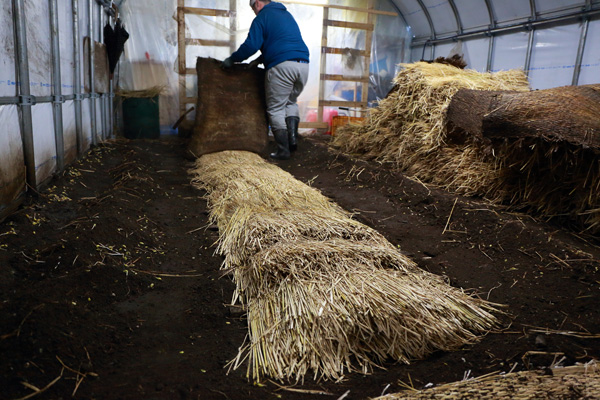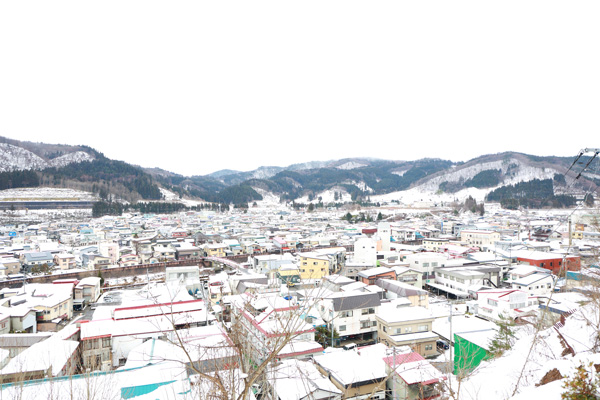The legendary Owani Onsen Bean Sprout, the Traditional Vegetable of a Medicinal Spa Town in the Tsugaru Region

In this Tsugaru hot spring town, there is a food that has been handed down through generations and is celebrated as a legendary vegetable for the region. This vegetable is the Owani Onsen Bean Sprout. As the name says, the Owani Onsen Bean Sprout uses the regional onsen ("hot springs") for cultivation. It is in the spotlight as a traditional and rare vegetable, as it is rarely sold on the market.
The Owani Onsen Bean Sprout grows to be a delicious vegetable through the use of hot springs and their heat

Owani Onsen Bean Sprouts use the blessings of its hometown—the abundant supply of hot springs—and their heat for cultivation. It is a traditional vegetable guarded fiercely by local farmers, with its secrets handed down only from father to son. There are documentary records stating its cultivation from more than 350 years ago, and these documents also state that the bean sprouts were always used as a selected offering when feudal lords of the Tsugaru Clan visited the Owani Town for spa treatments.
The nutrients and hot spring components in the soil heated by the hot spring heat create powerful, delicious bean sprouts unlike any others in the world. These sprouts grow to approximately 40 cm long and have a texture and crunchiness that is quite audible when eaten. It does away with all stereotypes regarding bean sprouts, and the way they are sold in bundles of 300 g wrapped in straw only make them more attractive.
This appetizing vegetable has been cherished between local citizens since ancient times. During the shipment season between November and May, the bean sprouts sell out the minute they hit the shelves at local stores. Even now, it is said that more than 70% of shipped bean sprouts are consumed locally.

How is the Owani Onsen Bean Sprout harvested? We visited Shota Yamaguchi’s greenhouse, one of the four bean sprout farms within the town.
We opened the door to a greenhouse full of hot spring heat and steam. A very sweaty Mr. Yamaguchi gave us a thorough explanation on how Owani Onsen Bean Sprouts were grown.
One major characteristic is that these bean sprouts are harvested in soil, which is a rarity for this type of vegetable. There are five cellars dug 40 cm deep and 80 cm wide in Mr. Yamaguchi’s farm. Here, a local breed of Owani soybean called kohachimame is sown in these underground pits and covered with a thin layer of soil to block light. No pesticides or chemical fertilizers are used, and only hot spring water is used for harvest—no tap water is used at all. Hot spring water are also used to wash off soil after harvesting as well.

There are pipes running underground carrying hot spring water. Bean sprouts grow rapidly only with the heat from these pipes and an occasional sprinkling of hot spring water, which is adjusted according to the growth status.
Nevertheless, bean sprouts are fast-growing but delicate vegetables that are easily affected by temperatures, humidity and light, meaning that the utmost care is needed for a successful harvest. Usually, harvest takes place approximately one week from seeding. However, due to affects from factors such as weather during this period, there are some cases where harvest takes place in four to five days. We were informed that there are cases in which the soil temperature rises too much due to much hot spring water sprinkled on the bean sprouts, causing the roots to rot.

“I am apprehensive every day I come to the greenhouse, as it does not take much to impact the health of the bean sprouts. I observe each bean sprout carefully before adjusting the temperature of the greenhouse and the amount of hot spring water. It looks like an easy task, but it is a crucial task that needs to be done every day, or tasty bean sprouts cannot be grown.”
There is more to bean sprout growing than what Mr. Yamaguchi told us—there is much more wisdom on how to cultivate fragrant and crunchy bean sprouts, but this information is confidential. Only successors to the bean sprout greenhouses are taught this information.
Bean sprouts are the hope for regional rebirth

The start of the JR Owani Onsen Station in 1895 led to the construction of ski resorts and many tourists from all over Japan flocking to Owani Town.
However, with the collapse of Japan’s economic bubble and a sharp decrease in tourists, many large-scale resorts failed to succeed. This resulted in many hardships for the town, because of its financial difficulties spawning from crippling debt.
In this situation, the Owani Onsen Bean Sprout was anticipated to be the secret weapon for rejuvenating the town, due to its increased exposure in the media as a “legendary traditional vegetable.”

However, the secrecy surrounding the harvest methods, which are handed down only to direct descendants of farmers, forced many farmers to close their business due to a lack of successors. Although there were approximately 30 bean sprout farmers at the peak, it had dwindled down to only a few. Because of this, the town started discussions more than ten years ago on how to preserve the tradition of Owani Onsen Bean Sprouts and create a brand. As a result, it was decided that accommodations were to be made for the town to teach non-farmer descendants the secrets of the bean sprouts, in order to train successors to Owani Onsen Bean Sprouts.

Mr. Yamaguchi is also a newly-inducted farmer who applied to the town’s recruitment scheme. The bean sprout secrets were handed down by predecessors to only selected applicants who had the physical hardiness, passion and personality to pass the strict screening and carry on the tradition and trust of Owani Onsen Bean Sprouts. At the moment, the number of bean sprout farmers have finally increased to four.
Hidetoshi Funamizu is the leader of the Owani Onsen Bean Sprout Production Promotion Committee, which works toward branding and training successors for the Owani Onsen Bean Sprout. He shared his outlook on the situation.

“Bean sprouts have a strong image of playing only a supporting role in meals. However, the Owani Onsen Bean Sprout has a texture that can act as a main dish. It is really delicious! I definitely do not want this vegetable to die out. Still, because locals are very familiar with the bean sprout from a long time ago, they have very strict standards on its taste. To start, locals need to offer their full support to new farmers for continued farming of bean sprouts that satisfy the local residents. And, in time, we want more people from outside of Aomori coming over to Owani Town to taste these Owani Onsen Bean Sprouts.”
Experiencing local hot spring bean sprout dishes

At Wanicome, a daytrip hot spring facility which is also the regional exchange center at the heart of the Owani local community, visitors can enjoy a wide variety of dishes featuring Owani Onsen Bean Sprouts at the facility restaurant.

One popular dish is the Owani Onsen Moyashi-umakadon (“bean sprout savory rice bowl”). This rice bowl features a layer of bean sprouts covering minced Aomori Shamorock chicken and a hot spring egg. Mixing this together creates an exquisite culinary experience with the crunchy texture of bean sprouts and robust chicken.
For visitors who want a simpler bean sprout experience, we recommend the Onsen Bean Sprout Shabushabu. Lightly parboiling the bean sprouts in hot water and dipping them in ponzu vinegar will allows visitors to enjoy the most direct and honest texture and fragrance of the regional bean sprouts.

This traditional hot spring bean sprout has been harvested with the blessings of the hot spring village and handed down within generations of farming families.
Do not scoff at the mention of the word “bean sprout.” Instead, visit the Owani Town for a first-hand experience in the extraordinary texture of these legendary bean sprouts.
Owani Onsen Bean Sprouts
Source:The Owani Onsen Bean Sprout Production Promotion Committee, Hidetoshi Funamizu
Peak Season
November to April
How to enjoy them
Shabu-shabu is recommended to experience the texture and excellent crunchiness of the bean sprouts.







